Corporate Guide
History of the Takara Group
-

-
- Chapter 1
-
The Founding of Takara Shuzo
1925–1945
The Founding of Takara Shuzo and the Nationwide Expansion of Shochu and Mirin
-
-
1
From a general partnership to a joint-stock corporation
-
1925
-
Takara Shuzo comes into existence and Usaburo Yomo is appointed as its first president
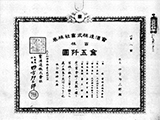
In 1925, when the liberal movement known as the Taisho Democracy was at its peak, Yomo GMK celebrated the 20th anniversary of its founding and reorganized itself into a joint-stock corporation, Takara Shuzo Co., Ltd. The company was named after a trademark known in the market, and Usaburo Yomo was appointed president. (Photo: Stock certificate at the time of establishment)
-

-
-
1
-
-
2
Nationwide expansion of shochu and mirin and revival of refined sake business
-
1925
-
The establishment of the Houkoukai and Sengokukai organizations
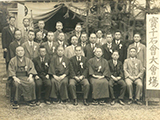
In 1925, the first year of brewing after the company's reorganization, a friendship association called Houkoukai was established with exclusive distributors in Tokyo and Yokohama. In 1927, the Sengokukai was organized for dealers who had sales capabilities comparable to those of exclusive distributors and who handled more than 1,000 koku of Takara products, and the sales network continued to expand. Not only did these organizations become the core of our sales activities, but they also helped build long-term relationships of trust with our customers. (Photo: A scene taken to commemorate the Sengokukai)
-

1926
-
Building of a nationwide network through mergers and acquisitions
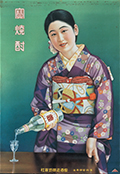
In 1926, at the request of a major manufacturer, Teikoku Shuzo KK, the company decided to merge. In 1929, Takara Shuzo Co., Ltd. merged with Tokyo-based Taisho Seishu KK and Hiroshima-based Tomo Houmeishuya KK. Later, in 1934, the company acquired wine-maker Daikoku Budoshu KK and Nippon Shuzo KK. These mergers and acquisitions allowed the company to expand its production network across all of Japan, with five plants. (Photo: Poster from the early Showa period)
-

1933
-
The establishment of Shochikubai Shuzo

In 1933, Shochikubai Shuzo KK was established to support Nada brewer Shinjiro Inoue, who had fallen into financial difficulty. The Shochikubai refined sake, which was launched with a price of 5 yen per two-liter bottle, almost five times higher than other refined sake, which drew a lot of attention and earned the product the moniker of "maboroshi no meishu" (famed sake of dreams). The opening of "Shochikubai-no-Sakagura" bars in major cities across Japan further boosted the sake's popularity. (Photo: A two-liter bottle of Shochikubai)
-

-
-
2
-
-
3
Initiatives to stabilize the industry
-
1924
-
The Establishment of the Six-Company Cooperative
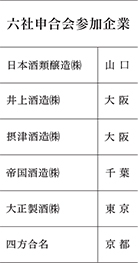
Takara Shuzo, which had grown dramatically to become one of Japan's leading shochu producers, also took initiatives to stabilize the industry amid the turmoil caused by the Great Kanto Earthquake and the ensuing financial crisis. First, in 1924, prior to the company's reorganization, the Six-Company Cooperative was formed by enlisting six major shochu makers. Numerous details regarding the balancing of supply and demand and the maintenance of prices were discussed among the six parties and moushiawase arrangements (cartels)* were drawn up, contributing greatly to the stabilization of the industry.
-

-
- *Moushiawase arrangements
- The enactment of competition laws in 1947 prohibited these arrangements (cartels) involving supply-and-demand balance and price fixing. Before the war, such activities were considered necessary for the stability of the industry and were not outlawed.
1928
-
The establishment of the All-Japan New-Style Mirin and Shochu Federation
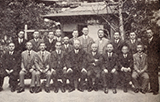
The financial crisis of 1927 had a profound effect on the Japanese economy, which remained in the doldrums, and the shochu industry was in turmoil. "The only way out of this situation is to create a nationwide industry association and conclude an even stronger industry agreement." That is how Usaburo Yomo saw the situation, and after presenting his ideas to the Ministry of Finance to secure its support, he traveled throughout Japan to call for the cooperation of others in the industry. The result was the formation in 1928 of the All-Japan New-Style Mirin and Shochu Federation, the first national organization of its kind in the liquor industry, which played a meaningful role in restricting production and maintaining prices. And, in 1931, the All-Japan New-Style Shochu Federation was formed. (Photo: Attendants of a meeting of the All-Japan New-Style Mirin and Shochu Federation)
-

1936
-
The Kyowakai and more efficient management
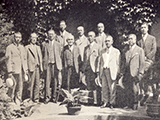
In 1933, an incident involving methyl alcohol poisoning occurred in Tokyo. Public fears about shochu heightened and Takara Shuzo, as a major seller in the Kanto market, suffered a major blow. The following year, prices soared due to the combination of a record-breaking poor harvest and damage caused by Typhoon Muroto. Rationalization of business operations and cost cutting were urgently needed. This led Takara Shuzo to decide to form a three-party alliance with Godo Shusei KK and Dainippon Shurui Jozo KK. In 1936, the Kyowakai association was formed. (Photo: Members of the Kyowakai association at the time of its establishment)
-

-
-
3
-
-
4
Wartime struggles
-
1937
-
Production of alcohol products for the military
In 1937, the Second Sino-Japanese War broke out. In Japan, wartime provisions were invoked and many industries became tightly regulated under controlled-economy policies. The Alcohol Monopoly Act became law that same year, and the government began to contract the manufacture of alcohol products to private businesses. Takara Shuzo received several of these contracts and began manufacturing alcohol fuel at facilities in Ichikawa, Oji, Fushimi, and Tomo. To handle this sudden increase in demand, in 1938 Takara Shuzo joined with Godo Shusei KK and Dainippon Shurui Jozo KK to establish Toa Shusei KK, a national policy company. Takara Shuzo then transferred the operation of the Kizaki Plant to Toa for use in the manufacture of alcohol fuel.
1940
-
The establishment of Manshu Shochikubai Shuzo
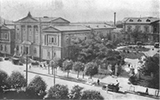
In contrast, Takara Shuzo’s refined sake business, which had been in full production since the launch of Sho Chiku Bai, was severely impacted by the introduction of the controlled economy. The 1939 rice crop failure only exacerbated the situation, and production volumes of refined sake were nearly halved. The company’s response was to establish Manshu Shochikubai Shuzo KK in 1940. Subsequently, sales of refined sake in Manchuria were well received by the Japanese living there at that time. (Photo: City of Dalian, Manchukuo / Courtesy of Mainichi Newspapers)
-

1940
-
Hidesaburo Yomo takes over as the second president of Takara Shuzo
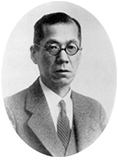
In 1940, the year before the outbreak of the Pacific War, Usaburo Yomo, who had led the company since its founding, stepped down as president and became chairman, saying, "Even without me in the front lines, there will be no change in the company’s fortunes." Hidesaburo Yomo (Photo) took the helm as the second president with Kurakichi Ohmiya as vice-president in the midst of troubled waters.
-

-
-
4

